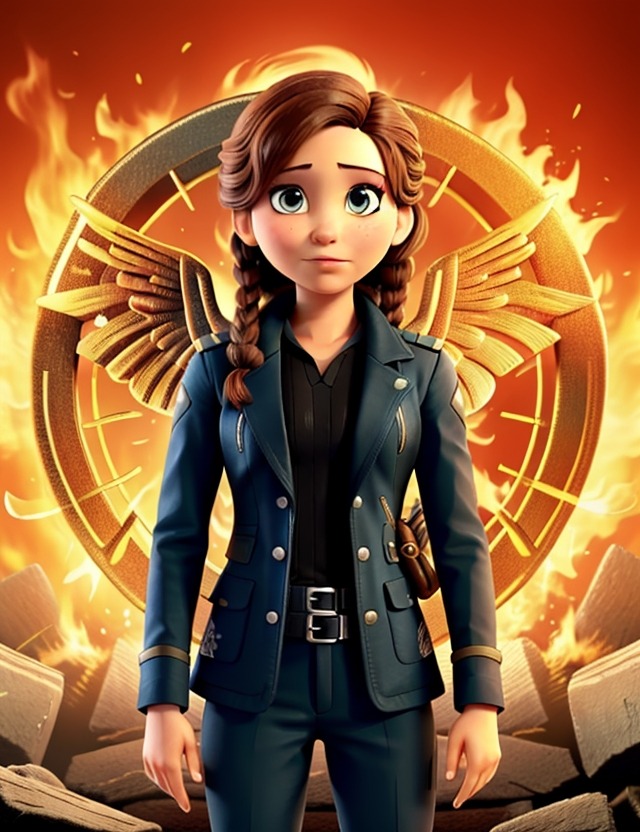In a dystopian world where survival is a game of life and death, one young girl’s courage and determination captivate readers from the very first page. Welcome to the extraordinary universe of “The Hunger Games,” a mesmerizing novel that has taken the literary world by storm. Unveiling a gripping narrative filled with heart-pounding action, thought-provoking themes, and a protagonist like no other, author Suzanne Collins has crafted an unforgettable tale that transcends genres and speaks to the very essence of our society. Brace yourself for an adrenaline-fueled journey as we delve into the intricacies of Panem, follow the indomitable Katniss Everdeen, and discover the true meaning of sacrifice, loyalty, and love.
Get ready to be enthralled as we unravel the hidden layers of this spellbinding tale and embark on a thrilling journey you won’t be able to resist – because in the world of “The Hunger Games,” the odds are never in your favor.
The Hunger Games: Full Book Summary
Once upon a time, in a world called Panem, there were twelve districts ruled by the rich and powerful Capitol. Every year, as a reminder of their defeat, the Capitol hosted the Hunger Games, a ruthless battle to the death among twenty-four teenagers – one boy and one girl from each district. This is the story of The Hunger Games, a thrilling and heartwarming tale of bravery, friendship, and the fight against injustice.
Our brave protagonist, Katniss Everdeen, lives in District 12, the poorest district of all. She is a skilled hunter and provider for her family, after her father’s untimely death in a mining accident. To keep her loved ones alive, Katniss must risk her life by sneaking beyond the electrified fence that surrounds her district, into the woods teeming with dangers.
But life takes a dark turn when her younger sister, Prim, is chosen as the female tribute for District 12 in the 74th Hunger Games. Unable to bear the thought of losing Prim, Katniss volunteers to take her place, sparking astonishment and admiration throughout the district. The boy chosen is Peeta Mellark, a gentle and talented baker’s son who once showed Katniss an act of kindness.
Together, Katniss and Peeta embark on a journey to the Capitol, where they meet their mentor, the alcoholic but experienced Haymitch Abernathy. Haymitch guides them through the training process, teaching them how to survive and make alliances. It is here that Katniss catches the eye of the wealthy, eccentric Cinna, who becomes their stylist and helps them make a lasting impression on the Capitol audience.
As the Games begin, Katniss and Peeta must battle against fierce adversaries from the other districts. The Games are a live televised event, with sponsors who can provide crucial supplies to the contestants. Katniss wins the admiration of many, as she displays her archery skills and survival instincts. The audience becomes enamored with her rebellious spirit and her fiery public displays of defiance against the Capitol.
During the Games, Katniss forms an unlikely alliance with Rue, a young girl from a farming district. They work together to outsmart the other tributes and get closer to victory. However, tragedy strikes when Rue is killed, and Katniss mourns her friend’s loss. In an act of defiance and honoring Rue’s memory, she places flowers on her lifeless body and salutes the sky.
As the Games progress, it becomes apparent to Katniss that the Capitol might have an ulterior motive for these brutal killings. Hoping to spark a rebellion in the districts, the Gamemakers attempt to force Katniss and Peeta to fight each other to the death. But instead of playing into their hands, Katniss and Peeta decide to defy the Capitol’s orders and threaten to commit suicide together. This act of rebellion forces the Gamemakers to declare them both victors, just as they are about to eat poisonous berries.
Returning to District 12 as the first-ever dual victors of the Hunger Games, Katniss and Peeta face another challenge – suppressing their supposed love for each other, which was part of a strategy to win the audience’s sympathy. However, Katniss discovers that her defiance in the Games has caught the attention of the Capitol’s President Snow, who sees her actions as a potential threat to his control over the districts.
As the story ends, Katniss and Peeta prepare to embark on a victory tour throughout the districts. But in the shadows, a rebellion is brewing, sparked by Katniss’s defiance and her hope for a better future. The Hunger Games have left a lasting impact on her, and she vows to fight for justice and freedom for all the districts. Little does she know that in the upcoming books, she will be propelled into a dangerous and deadly war, where her courage and determination will be put to the ultimate test.
The Hunger Games is a gripping and thought-provoking tale that explores themes of inequality, oppression, and the power of hope. It highlights the importance of standing up for what you believe in, even in the face of adversity. As children, we can learn from Katniss’s bravery and resilience, and be inspired to fight for fairness and justice in our own lives. Let her story ignite the flames of rebellion within us, and may we always remember that even the smallest spark can lead to a blaze that will change the world.
Key Theme of Hunger Games
“The Hunger Games” is a dystopian novel written by Suzanne Collins, set in a post-apocalyptic future where the nation of Panem holds an annual event called “the Hunger Games.” Here are three key themes found in the book:
1. Survival and Sacrifice: The most prominent theme in “The Hunger Games” is survival. The story revolves around a brutal competition where one boy and one girl from each of Panem’s twelve districts are chosen to fight to the death in an arena. Throughout the book, the characters face life-threatening situations and must make difficult choices to stay alive. We witness acts of sacrifice, both big and small, as characters risk their lives for others or make alliances to increase their chances of survival.
2. Power and Oppression: Another important theme in the book is the abuse of power and the oppressive regime that controls Panem. The Capitol, the central government, holds absolute authority over the districts. The Hunger Games themselves serve as a reminder of this power imbalance, as the Capitol forces young people to fight one another for entertainment and to maintain control. The stark contrast between the extravagant lifestyles of the Capitol citizens and the poverty and hardship endured in the districts highlights the oppressive nature of the ruling class.
3. Rebellion and Hope: “The Hunger Games” also explores the theme of rebellion and the power of hope. As the story unfolds, protagonist Katniss Everdeen’s defiance against the Capitol becomes a symbol of resistance. Her actions inspire others and ignite a spark of hope. Through the characters’ struggles and small acts of rebellion, the book emphasizes the potential for change and the belief that standing up against injustice can lead to a better future.
These themes intertwine to create a captivating narrative that explores complex ideas of survival, power dynamics, and the significance of hope in the face of oppression.
The Hunger Games: Characters
1. Katniss Everdeen: The fierce and resourceful protagonist of the story. With her olive skin, long dark hair, and grey eyes, she possesses a strong and determined aura. Known for her exceptional archery skills and survival instincts, Katniss is the ultimate survivor in the Hunger Games arena. As a fun fact, she has an incredible fondness for her bow and arrow and an unending love for Primrose, her younger sister.
2. Peeta Mellark: The brave and cunning tribute from District 12. Peeta, with his blonde hair and captivating blue eyes, has a charm that draws everyone in. Gifted in painting and baking, he uses his creativity to navigate the treacherous game of politics within the Hunger Games. Peeta is also famous for his ability to camouflage himself perfectly with his surroundings.
3. Gale Hawthorne: Katniss’s best friend and hunting partner. With his tousled black hair and striking grey eyes, Gale exudes quiet strength and determination. A skilled hunter and rebel at heart, Gale often challenges the oppressive Capitol, providing essential support to Katniss during her fight for survival. A funny quirk about him is his knack for naming the animals he encounters during hunting expeditions.
4. Effie Trinket: District 12’s eccentric and fashion-forward escort. Effie, with her vividly colored wigs and over-the-top outfits, is the epitome of Capitol fashion. Her love for order and punctuality is often displayed through her flamboyant personality. A fun fact about Effie is her obsession with intricate table settings, ensuring that every meal is a feast for the eyes, even in the direst circumstances.
5. Haymitch Abernathy: The drunken mentor assigned to Katniss and Peeta. With unruly grey hair and constant scruff, Haymitch’s appearance matches his gruff attitude. Once a victor of the Hunger Games himself, his strategic mind and unyielding sarcasm make him the ideal ally for the tributes. Despite his flaws, Haymitch’s loyalty to his District is unwavering, even when he’s inebriated.
6. Primrose Everdeen: Katniss’s beloved younger sister. Described as delicate and fair, with golden ringlets and bright blue eyes, Prim is the embodiment of innocence in a grim world. Despite her fragile appearance, Prim possesses a formidable strength and kindness that inspires those around her. One amusing character trait is her talent for caring for injured animals, often tending to them with unwavering dedication.
7. Cinna: Katniss’s deeply loyal and talented stylist. With his calm demeanor and close-cropped black hair, Cinna possesses an understated elegance. His skillful design aesthetic helps Katniss shine in the Hunger Games arena. In secret, Cinna is a passionate advocate for rebellion against the Capitol, using fashion as a form of silent protest. A surprising tidbit about Cinna is his love for classical music and playing the piano.
8. Rue: The young and nimble tribute from District 11. With her dark skin, big brown eyes, and braided hair, Rue has an endearing and innocent presence. Quick and silent, she becomes a trusted companion to Katniss during the Games. Rue’s fondness for singing beautiful melodies brings moments of solace and hope amidst the chaos. It’s also worth noting that Rue has a knack for identifying edible plants and their medicinal properties.
9. President Snow: The merciless and enigmatic leader of the Capitol. With his sleek white hair and cold blue eyes, President Snow embodies power and control. His calculated and manipulative nature keeps the districts under his thumb. A quirky fact about him is his obsession with white roses, often filling his office with their fragrance.
10. Cato: The fierce and imposing tribute from District 2. With his muscular build, chiseled features, and icy blue eyes, Cato exudes intimidation. As a career tribute, he is ruthless in his pursuit of victory, never hesitating to eliminate his opponents. Cato’s love for adrenaline-pumping activities and extreme sports outside of the arena makes him a formidable adversary.
The Hunger Games: Symbols
1. Mockingjay Pin: The mockingjay pin is a prominent symbol throughout The Hunger Games series, representing both defiance and hope. Katniss Everdeen, the protagonist, wears the pin as a tribute to her home district, District 12, as well as a symbol of rebellion against the oppressive Capitol. The mockingjay itself is a hybrid bird, a result of the Capitol’s genetic modification experiments. It becomes a symbol of resistance as Katniss becomes a symbol of hope to the people of Panem. The mockingjay pin serves as a reminder of the oppression the districts face and their collective desire for freedom.
2. The Arena: The Arena is an artificial environment where the Hunger Games take place. It serves as a physical manifestation of the Capitol’s control and power over the districts. The Arena changes from one Hunger Games to another, filled with traps, obstacles, and deadly surprises. It represents the Capitol’s ability to manipulate and entertain the citizens with violence. The Arena becomes a symbol of the Capitol’s control and the skewed value system of Panem, where human life can be treated as mere entertainment.
3. Katniss’s Bow and Arrow: Katniss’s bow and arrow become powerful symbols of her independence, survival, and resistance against the Capitol. Throughout the series, Katniss’s skill with her bow and arrow becomes a weapon against both the oppressive Capitol forces during the Hunger Games and the rebel forces in the Mockingjay uprising. The bow and arrow also symbolize Katniss’s connection to her father, who taught her archery before his death, and her ability to provide for her family. Katniss using her bow and arrow effectively signifies her defiance against the Capitol’s attempt to control and manipulate her during the Hunger Games.
The Hunger Games: Culture Impact
The release of “The Hunger Games” by Suzanne Collins in 2008 sparked a cultural phenomenon that captivated the world. This dystopian novel, set in a post-apocalyptic future, quickly became a global sensation, permeating various aspects of popular culture and leaving an indelible mark on society.
Historically, “The Hunger Games” had a profound impact on the young adult literature genre. It rejuvenated the genre by introducing a complex and gritty narrative, breaking away from the conventional tropes and often catering to a more mature audience. This book pushed the boundaries of what was considered appropriate for young readers, effectively expanding the possibilities for storytelling in this genre.
The novel’s success also deeply impacted the film industry. The subsequent film adaptations, starting in 2012, garnered a massive following, solidifying the book’s status as a cultural phenomenon. The movies brought the dystopian world of Panem to life, allowing fans to visually experience the intricate costumes, breathtaking sets, and heart-pounding action sequences that were initially imagined through Collins’ words. The success of the films further contributed to the book’s popularity and created a lasting impact on the cinematic landscape.
“The Hunger Games” did not only entertain; it also raised awareness about important social issues. By depicting a society divided into districts, each struggling under the oppressive rule of the Capitol, the novel shed light on socio-political inequalities and the abuse of power. It prompted discussions about class systems, exploitation, and the consequences of a government that prioritizes control over compassion. Through its thought-provoking themes, the book encouraged readers to reflect on their own world and inspired them to take action to create a fairer society.
Despite the often dark subject matter, “The Hunger Games” managed to inject humor into its narrative, providing moments of levity amidst the intense and often dire situations faced by the characters. These light-hearted, witty moments served as a stark contrast to the bleakness of their circumstances, allowing readers to experience a range of emotions throughout the story. The infusion of humor not only made the book more engaging and enjoyable but also showcased Collins’ skill in blending various tones to create a well-rounded narrative.
Ultimately, “The Hunger Games” stands as a cultural milestone. It not only entertained and enthralled readers but also impacted the literary and cinematic realms, pushing the boundaries of storytelling. Through its thought-provoking themes, it also provided a platform for discussion and introspection, encouraging readers to critically examine their own society. With its ability to balance seriousness with humor, this book creates an unforgettable reading experience that will continue to resonate with audiences for generations to come.
FAQs
1. What is The Hunger Games about?
The Hunger Games is a dystopian young adult novel written by Suzanne Collins. It is set in a post-apocalyptic world where the government selects a boy and girl from each of the twelve districts to fight to the death in a televised event called the Hunger Games.
2. Who is the author of The Hunger Games?
The Hunger Games is written by Suzanne Collins. She is an American author known for her popular young adult fiction series, including the Hunger Games trilogy.
3. How many books are there in the Hunger Games series?
The Hunger Games series consists of three books: The Hunger Games, Catching Fire, and Mockingjay.
4. Is The Hunger Games a movie as well?
Yes, The Hunger Games has been adapted into a successful film franchise. The first movie was released in 2012, followed by three sequels: Catching Fire, Mockingjay – Part 1, and Mockingjay – Part 2.
5. What is the age range for readers of The Hunger Games?
The Hunger Games is intended for young adult readers, typically aged 12 and above. However, the series has also been enjoyed by older readers due to its compelling story and themes.
6. What is the Hunger Games and why do they exist?
The Hunger Games is an annual event in which one boy and one girl aged 12–18 from each of the twelve districts of Panem are selected by lottery to compete in a televised battle royale to the death. The Hunger Games are a punishment for a past rebellion against the Capitol, the totalitarian government that rules Panem. The Hunger Games are also a means of entertainment and propaganda for the Capitol, which broadcasts the Games to the entire nation and forces the districts to watch their children fight and die.
7. Who are Katniss Everdeen and Peeta Mellark and how do they become the tributes for District 12?
Katniss Everdeen is a 16-year-old girl who lives in District 12, the poorest and most oppressed district in Panem. She is a skilled hunter and archer who provides for her mother and younger sister, Prim, by illegally hunting in the woods outside the district. Peeta Mellark is a 16-year-old boy who is the son of a baker in District 12. He has a crush on Katniss and once gave her bread when she was starving. Katniss and Peeta become the tributes for District 12 when Prim’s name is drawn in the reaping, the lottery that selects the tributes, and Katniss volunteers to take her place. Peeta’s name is also drawn, and they are escorted to the Capitol by their mentor, Haymitch Abernathy, a former victor of the Hunger Games, and their stylist, Effie Trinket.
8. What is the significance of the mockingjay pin that Katniss wears in the Games?
The mockingjay pin is a gold pin that depicts a mockingjay, a hybrid bird that resulted from the mating of jabberjays and mockingbirds. Jabberjays were genetically engineered by the Capitol to spy on the rebels during the Dark Days, the war that led to the first rebellion, but they were abandoned when the rebels realized their purpose and used them to spread false information. Mockingjays inherited the ability to mimic sounds from jabberjays, but they also learned to sing and communicate with humans. The mockingjay pin is a symbol of defiance and resistance against the Capitol, especially after Katniss wears it as her token in the Games. She receives the pin from her friend Madge Undersee, the mayor’s daughter, who tells her that it belonged to her aunt, who died in the previous rebellion. The pin also helps Katniss form an alliance with Rue, a tribute from District 11, who recognizes the pin and uses mockingjay songs to communicate with Katniss in the arena.
9. How do Katniss and Peeta survive the Games and win the hearts of the audience?
Katniss and Peeta survive the Games by using their skills, intelligence, and luck. Katniss uses her archery and hunting skills to find food, water, and weapons. Peeta uses his strength and camouflage skills to hide and avoid danger. They also benefit from the gifts and advice of their sponsors, who are wealthy people from the Capitol or other districts who can send them supplies and medicine through parachutes. Katniss and Peeta win the hearts of the audience by pretending to be star-crossed lovers, a strategy devised by Haymitch to gain sympathy and support. They also show compassion and courage by helping and protecting each other and other tributes, such as Rue and Thresh. They also defy the Capitol by refusing to kill each other when they are the last two tributes remaining, and threaten to commit suicide by eating poisonous berries. This forces the Gamemakers to declare them both as victors, but also makes them enemies of the Capitol, which sees their act as a rebellion.
10. What is the cliffhanger ending of the book and what does it mean for the sequel?
The book ends with Katniss and Peeta returning to District 12 as the winners of the 74th Hunger Games. However, they are not safe, as they have angered the Capitol and President Snow, who considers their act of defiance as a spark for a possible uprising. Katniss also realizes that she has feelings for both Peeta and Gale, her best friend and hunting partner, who kisses her when he sees her again. She is confused and conflicted about her emotions, and does not know how to act around Peeta, who truly loves her. The book ends with Katniss saying, “I feel like I owe him something, and I hate owing people. Maybe if I had thanked him at some point, I’d be feeling less conflicted now. I thought about it a couple of times, but the opportunity never seemed to present itself. And now it never will. Because we’re going to be thrown into an arena to fight to the death. Exactly how am I supposed to work in a thank-you in there? Somehow it just won’t seem sincere if I’m trying to slit his throat.” This ending sets up the stage for the sequel, The Hunger Games: Catching Fire, which will show the consequences of Katniss and Peeta’s actions, and the rising tension and rebellion in the districts.










